 The third of the Regional Championships is coming up – lots of Kona points, decent prize money and automatic qualifying spots for the two winners have attracted strong fields.
The third of the Regional Championships is coming up – lots of Kona points, decent prize money and automatic qualifying spots for the two winners have attracted strong fields.
Update May 12th: Based on the latest startlist I added bib for Mareen Hufe, added Felipe Manente, and removed Alicia Kaye.
Update May 23rd: I’ve added a detailed preview for the Men’s Race.
Update May 25th: There’s also a detailed preview for the Female Race.
Update May 27th: Laurel Wassner won’t be racing Brasil, she’s now targeting one of the European Ironman races.
Previous Winners
| Year |
Male Winner |
Time |
Female Winner |
Time |
| 2005 |
Olaf Sabatschus (GER) |
08:50:37 |
Joanna Zeiger (USA) |
09:31:43 |
| 2006 |
Oscar Galindez (ARG) |
08:15:19 |
Lisbeth Kristensen (DEN) |
09:20:47 |
| 2007 |
Oscar Galindez (ARG) |
08:21:09 |
Nina Kraft (GER) |
09:12:40 |
| 2008 |
Eduardo Sturla (ARG) |
08:28:24 |
Fernanda Keller (BRA) |
09:42:50 |
| 2009 |
Eduardo Sturla (ARG) |
08:13:39 |
Dede Griesbauer (USA) |
09:10:15 |
| 2010 |
Luke McKenzie (AUS) |
08:07:38 |
Tereza Macel (CZE) |
09:19:12 |
| 2011 |
Eduardo Sturla (ARG) |
08:13:12 |
Amy Marsh (USA) |
09:07:49 |
| 2012 |
Ezequiel Morales (ARG) |
08:22:40 |
Sofie Goos (BEL) |
09:17:42 |
| 2013 |
Timothy O’Donnell (USA) |
08:01:32 |
Amanda Stevens (USA) |
09:05:53 |
| 2014 |
Igor Amorelli (BRA) |
08:07:54 |
Sara Gross (CAN) |
08:56:35 |
| 2015 |
Marino Vanhoenacker (BEL) |
07:53:44 |
Ariane Monticeli (BRA) |
08:59:08 |
| 2016 |
Brent McMahon (CAN) |
07:46:10 |
Elizabeth Lyles (USA) |
08:54:10 |
Last Year’s TOP 3
Male Race Results
| Rank |
Name |
Nation |
Swim |
Bike |
Run |
Time |
| 1 |
Brent McMahon |
CAN |
00:47:47 |
04:11:54 |
02:42:52 |
07:46:10 |
| 2 |
Tim Don |
GBR |
00:47:49 |
04:22:01 |
02:50:27 |
08:04:15 |
| 3 |
Kevin Collington |
USA |
00:47:58 |
04:23:48 |
02:48:48 |
08:04:58 |
Female Race Results
| Rank |
Name |
Nation |
Swim |
Bike |
Run |
Time |
| 1 |
Elizabeth Lyles |
USA |
00:56:52 |
04:48:37 |
03:03:48 |
08:54:10 |
| 2 |
Mareen Hufe |
GER |
01:01:22 |
04:51:32 |
03:11:02 |
09:09:36 |
| 3 |
Gurutze Frades Larralde |
ESP |
01:01:26 |
05:00:36 |
03:08:54 |
09:15:52 |
Course Records
| Leg |
Gender |
Record |
Athlete |
Date |
| Total |
overall |
07:46:10 |
Brent McMahon |
2016-05-29 |
| Swim |
overall |
00:42:26 |
Luke McKenzie |
2010-05-30 |
| Bike |
overall |
04:11:23 |
Marino Vanhoenacker |
2015-05-31 |
| Run |
overall |
02:42:52 |
Brent McMahon |
2016-05-29 |
| Total |
female |
08:54:10 |
Elizabeth Lyles |
2016-05-29 |
| Swim |
female |
00:45:48 |
Dede Griesbauer |
2010-05-30 |
| Bike |
female |
04:46:38 |
Jessie Donavan |
2014-05-25 |
| Run |
female |
02:56:28 |
Ariane Monticeli |
2015-05-31 |
Course Rating
The Course Rating for IM Brasil is 21:43.
Race Adjustments for IM Brasil
| Year |
Adjustment |
Swim Adj. |
Bike Adj. |
Run Adj. |
# of Finishers |
Rating |
Swim Rating |
Bike Rating |
Run Rating |
| 2006 |
26:07 |
02:15 |
07:01 |
04:41 |
37 |
26:07 |
02:15 |
07:01 |
04:41 |
| 2007 |
19:38 |
00:14 |
07:38 |
03:25 |
40 |
22:52 |
01:15 |
07:19 |
04:03 |
| 2008 |
13:11 |
-06:09 |
14:07 |
-00:36 |
45 |
19:38 |
-01:13 |
09:35 |
02:30 |
| 2009 |
22:14 |
00:15 |
11:28 |
04:42 |
39 |
20:17 |
-00:51 |
10:03 |
03:03 |
| 2010 |
26:28 |
04:18 |
09:25 |
00:26 |
42 |
21:32 |
00:11 |
09:56 |
02:32 |
| 2011 |
25:42 |
n/a |
n/a |
n/a |
29 |
22:13 |
00:11 |
09:56 |
02:32 |
| 2012 |
20:18 |
02:37 |
22:28 |
-05:16 |
32 |
21:57 |
00:35 |
12:01 |
01:14 |
| 2013 |
18:33 |
02:57 |
17:03 |
03:13 |
41 of 45 |
21:31 |
00:55 |
12:44 |
01:31 |
| 2014 |
26:59 |
00:48 |
22:40 |
04:39 |
34 of 40 |
22:08 |
00:54 |
13:59 |
01:54 |
| 2015 |
21:31 |
00:23 |
19:50 |
05:47 |
33 of 47 |
22:04 |
00:51 |
14:38 |
02:20 |
| 2016 |
18:17 |
-00:21 |
18:20 |
03:49 |
27 of 39 |
21:43 |
00:44 |
15:00 |
02:29 |
KPR points and Prize Money
IM Brasil is a P-4000 race. It has a total prize purse of 150.000 US$.
Estimated Time Plan
The following table shows the time plan for the race start and the estimated times for the first athlete in the transition zones or across the finish line. The estimates are based on the start time and my time estimates, these times can change based on how fast or slow the race ends up:
| What |
Est. Racetime |
Est. Local Time |
| Male Pro Start |
|
06:45 |
| Female Pro Start |
|
06:50 |
| Age Group Wave Start |
|
07:05 – 07:35 |
| First Male in T1 |
0:46 |
7:31 |
| First Female in T1 |
0:48 |
7:38 |
| First Male in T2 |
5:05 |
11:50 |
| First Female in T2 |
5:51 |
12:41 pm |
| Male Winner |
7:50 |
2:35pm |
| Female Winner |
8:55 |
3:45 pm |
Florianopolis is on Brasilia Time, 3 hours behind UTC. Here are the conversions to a few other time zones:
- + 13 hours: Sydney (AEST), race starts at 7:45pm
- + 5: Central Europe (CEST), race starts at 11:45am
- +4 hours: United Kingdom (BST), race starts at 10:45am
- – 1 hour: US East Coast (EDT), race starts at 5:45am
- – 4 hours: US West Coast (PDT), race starts at 2:45am
Male Race Participants
The strength of the field is 29% of a typical Kona field.
Ty Butterfield is safe for Kona after his third place in Texas and unlikely to race. I have put his name in brackets as he is still on the official list.
| Rank |
Bib |
Name |
Nation |
Expected Time |
Rating |
Exp. Swim |
Exp. Bike |
Exp. Run |
Consistency |
Overall |
| 1 |
1 |
Brent McMahon |
CAN |
07:49:28 |
08:16:06 |
00:46:13 |
04:14:06 |
02:44:08 |
80% +0% -20% (7) |
4 |
| 2 |
36 |
Andreas Raelert |
GER |
08:01:19 |
08:29:46 |
00:47:53 |
04:17:39 |
02:50:47 |
22% +10% -68% (21) |
28 |
| 3 |
2 |
Tim Don |
GBR |
08:03:14 |
08:32:43 |
00:46:27 |
04:22:01 |
02:49:46 |
64% +0% -36% (4) |
40 |
| 4 |
6 |
Ivan Tutukin |
RUS |
08:03:39 |
08:41:47 |
00:47:01 |
04:32:21 |
02:39:17 |
43% +0% -57% (2) |
(75) |
| (5) |
11 |
(Tyler Butterfield) |
BMU |
08:04:10 |
08:31:23 |
00:47:39 |
04:18:37 |
02:52:54 |
37% +32% -30% (14) |
34 |
| 6 |
3 |
Igor Amorelli |
BRA |
08:08:08 |
08:40:48 |
00:46:34 |
04:20:53 |
02:55:41 |
28% +17% -54% (14) |
70 |
| 7 |
42 |
Eneko Llanos |
ESP |
08:08:48 |
08:28:55 |
00:47:26 |
04:16:21 |
03:00:01 |
92% +0% -8% (29) |
26 |
| 8 |
53 |
Paul Matthews |
AUS |
08:09:04 |
08:40:04 |
00:46:09 |
04:23:22 |
02:54:32 |
37% +0% -63% (13) |
68 |
| 9 |
8 |
Kyle Buckingham |
ZAF |
08:09:10 |
08:33:44 |
00:48:09 |
04:23:01 |
02:53:00 |
51% +17% -32% (12) |
42 |
| 10 |
51 |
Matt Chrabot |
USA |
08:09:35 |
08:44:38 |
00:47:23 |
04:23:55 |
02:53:17 |
8% +34% -58% (5) |
(82) |
| 11 |
44 |
Fabio Carvalho |
BRA |
08:10:16 |
09:12:33 |
00:46:45 |
04:26:57 |
02:51:33 |
1% +35% -64% (12) |
172 |
| 12 |
54 |
Pedro Gomes |
POR |
08:14:42 |
08:35:16 |
00:51:38 |
04:27:46 |
02:50:18 |
67% +1% -31% (25) |
54 |
| 13 |
4 |
Guilherme Manocchio |
BRA |
08:16:36 |
08:39:00 |
00:49:24 |
04:25:35 |
02:56:37 |
66% +18% -16% (13) |
63 |
| 14 |
47 |
Frank Silvestrin |
BRA |
08:21:01 |
08:56:42 |
00:48:46 |
04:32:45 |
02:54:30 |
31% +62% -7% (7) |
122 |
| 15 |
43 |
Esben Hovgaard |
DEN |
08:22:10 |
08:52:12 |
00:51:20 |
04:27:07 |
02:58:43 |
41% +38% -21% (11) |
103 |
| 16 |
50 |
Mario De Elias |
ARG |
08:22:58 |
08:54:17 |
00:50:26 |
04:33:23 |
02:54:09 |
32% +38% -30% (8) |
110 |
| 17 |
48 |
Luis Henrique Ohde |
BRA |
08:23:59 |
08:53:20 |
00:46:59 |
04:34:39 |
02:57:21 |
100% +0% -0% (2) |
(109) |
| 18 |
37 |
Barrett Brandon |
USA |
08:25:09 |
08:49:18 |
00:46:22 |
04:33:37 |
03:00:10 |
63% +0% -37% (8) |
95 |
| 19 |
5 |
Harry Wiltshire |
GBR |
08:27:06 |
09:02:07 |
00:46:39 |
04:34:50 |
03:00:37 |
31% +20% -49% (20) |
145 |
| 20 |
56 |
Reinaldo Colucci |
BRA |
08:27:17 |
08:52:55 |
00:47:47 |
04:27:28 |
03:07:02 |
89% +11% -0% (6) |
(106) |
| 21 |
55 |
Philipp Koutny * |
SUI |
08:28:23 |
09:00:58 |
00:50:06 |
04:28:54 |
03:04:23 |
26% +0% -74% (4) |
(142) |
| 22 |
10 |
Thiago Vinhal |
BRA |
08:29:37 |
09:00:08 |
00:47:54 |
04:40:47 |
02:55:57 |
72% +18% -10% (12) |
136 |
| 23 |
58 |
Sylvain Sudrie |
FRA |
08:29:53 |
09:04:38 |
00:49:06 |
04:33:24 |
03:02:23 |
53% +0% -47% (2) |
(153) |
| 24 |
52 |
Patrick Evoe |
USA |
08:35:20 |
09:00:50 |
00:54:36 |
04:29:39 |
03:06:05 |
77% +4% -20% (25) |
140 |
| 25 |
46 |
Fellipe Santos |
BRA |
08:45:12 |
09:22:23 |
00:47:36 |
04:45:47 |
03:06:49 |
n/a (1 IM Pro race) |
(201) |
| (25) |
61 |
Felipe De Oliveira Manente |
BRA |
08:54:11 |
09:37:13 |
00:52:17 |
04:44:33 |
03:12:21 |
18% +7% -75% (8) |
(237) |
| 26 |
49 |
Luiz Francisco Paiva Ferreira |
BRA |
09:19:45 |
09:57:54 |
00:45:25 |
04:41:39 |
03:47:41 |
n/a (1 IM Pro race) |
(273) |
| 27 |
39 |
Christian Carletto |
ARG |
09:19:57 |
09:51:24 |
00:56:19 |
04:57:47 |
03:20:51 |
92% +8% -0% (9) |
261 |
| 28 |
38 |
Bruno Matheus |
BRA |
09:31:37 |
10:10:34 |
00:49:22 |
05:06:43 |
03:30:32 |
n/a (1 IM Pro race) |
(280) |
| 29 |
7 |
Josef Svoboda |
CZE |
11:00:33 |
11:51:37 |
01:14:31 |
05:36:55 |
04:04:06 |
54% +18% -28% (16) |
299 |
|
40 |
Diego Vasquez |
ECU |
n/a |
unrated |
unrated |
unrated |
unrated |
n/a (no IM Pro race) |
(n/a) |
|
41 |
Eduardo Diaz |
ARG |
n/a |
unrated |
unrated |
unrated |
unrated |
n/a (no IM Pro race) |
(n/a) |
|
45 |
Felipe Van de Wyngard |
CHI |
n/a |
unrated |
unrated |
unrated |
unrated |
n/a (no IM Pro race) |
(n/a) |
|
57 |
Rodrigo Sanchez |
ARG |
n/a |
unrated |
unrated |
unrated |
unrated |
n/a (no IM Pro race) |
(n/a) |
|
59 |
Vinicius Canhedo |
BRA |
n/a |
unrated |
unrated |
unrated |
unrated |
n/a (1 IM Pro race) |
(n/a) |
Note:Athletes with a ‘*’ are also registered for another race within 8 days.
Female Race Participants
The strength of the field is 24% of a typical Kona field.
There are some questions about the start list as published by Ironman. Therefore I have included Mareen Hufe in my calculations as I’m aware that she fully intends to race and was included in earlier versions of the entry list. Alicia Kaye is safe for Kona after her fourth place in Texas and unlikely to race another full IM before Kona. I have put Alicia’s name in brackets as she is still on the official list.
| Rank |
Bib |
Name |
Nation |
Expected Time |
Rating |
Exp. Swim |
Exp. Bike |
Exp. Run |
Consistency |
Overall |
| 1 |
35 |
Susie Cheetham |
GBR |
08:54:32 |
09:14:17 |
00:53:30 |
04:53:31 |
03:02:32 |
78% +0% -22% (6) |
6 |
| 2 |
29 |
Linsey Corbin |
USA |
08:56:41 |
09:18:58 |
00:56:53 |
04:52:16 |
03:02:32 |
89% +11% -0% (21) |
10 |
| 3 |
60 |
Mareen Hufe |
GER |
09:05:07 |
09:30:03 |
00:59:20 |
04:47:17 |
03:13:30 |
76% +15% -8% (23) |
28 |
| 4 |
34 |
Sonja Tajsich |
GER |
09:06:36 |
09:33:03 |
01:00:46 |
04:51:26 |
03:09:24 |
71% +6% -23% (22) |
(32) |
| 5 |
23 |
Haley Chura |
USA |
09:08:54 |
09:39:36 |
00:48:10 |
04:58:17 |
03:17:27 |
64% +14% -22% (9) |
(43) |
| 6 |
18 |
Elisabeth Gruber |
AUT |
09:09:35 |
09:37:10 |
01:01:00 |
04:58:48 |
03:04:47 |
94% +6% -0% (8) |
37 |
(7) |
12 |
(Alicia Kaye) |
USA |
09:12:13 |
09:37:25 |
00:50:59 |
04:58:33 |
03:17:42 |
59% +41% -0% (3) |
38 |
| 8 |
22 |
Gurutze Frades Larralde |
ESP |
09:15:17 |
09:45:05 |
00:59:51 |
05:02:27 |
03:07:59 |
51% +29% -20% (8) |
52 |
9 |
28 |
Laurel Wassner |
USA |
09:16:07 |
09:44:50 |
00:53:15 |
05:07:31 |
03:10:22 |
63% +16% -21% (10) |
51 |
| 10 |
13 |
Annah Watkinson |
ZAF |
09:16:24 |
09:50:26 |
00:56:54 |
04:57:00 |
03:17:30 |
68% +0% -32% (4) |
61 |
| 11 |
17 |
Celine Schaerer |
SUI |
09:17:45 |
09:44:26 |
00:50:12 |
05:04:19 |
03:18:13 |
89% +0% -11% (8) |
50 |
| 12 |
27 |
Kristin Moeller |
GER |
09:18:10 |
09:48:30 |
01:01:48 |
05:11:16 |
03:00:06 |
69% +7% -24% (22) |
56 |
| 13 |
26 |
Kirsty Jahn |
CAN |
09:18:13 |
10:02:13 |
00:58:01 |
05:08:33 |
03:06:40 |
32% +0% -68% (2) |
(78) |
| 14 |
33 |
Pamela Tastets |
CHI |
09:18:17 |
09:56:19 |
00:55:57 |
05:00:57 |
03:16:22 |
n/a (1 IM Pro race) |
(71) |
| 15 |
15 |
Brooke Brown |
CAN |
09:28:25 |
10:09:10 |
01:00:56 |
05:04:09 |
03:18:20 |
35% +0% -65% (10) |
94 |
| 16 |
31 |
Mariana Andrade |
BRA |
09:31:52 |
10:26:31 |
00:58:26 |
05:01:42 |
03:26:44 |
11% +38% -51% (12) |
125 |
| 17 |
32 |
Nicole Valentine |
USA |
09:40:35 |
10:22:26 |
01:03:28 |
05:18:08 |
03:14:00 |
46% +54% -0% (2) |
(116) |
| 18 |
24 |
Jenny Fletcher |
CAN |
09:41:29 |
10:15:27 |
00:56:37 |
05:09:39 |
03:30:13 |
100% +0% -0% (2) |
(107) |
| 19 |
14 |
Ashley Paulson |
USA |
09:45:33 |
10:20:16 |
01:11:18 |
05:17:21 |
03:11:54 |
69% +0% -31% (4) |
113 |
| 20 |
20 |
Bruna Mahn |
BRA |
09:52:15 |
10:24:53 |
00:55:23 |
05:25:59 |
03:25:53 |
46% +54% -0% (2) |
(122) |
| 21 |
25 |
Kate Bruck |
USA |
09:58:20 |
10:33:25 |
01:02:10 |
05:24:14 |
03:26:57 |
60% +0% -40% (4) |
138 |
|
16 |
Carolina Furriela |
BRA |
n/a |
unrated |
unrated |
unrated |
unrated |
n/a (no IM Pro race) |
(n/a) |
|
19 |
Erika Simon |
ARG |
n/a |
unrated |
unrated |
unrated |
unrated |
n/a (no IM Pro race) |
(n/a) |
|
30 |
Magali Tisseyre |
CAN |
n/a |
unrated |
unrated |
unrated |
unrated |
n/a (no IM Pro race) |
(n/a) |
Winning Odds
Male Race Participants
Last year’s winner (and course record holder) Brent McMahon is back to defend his title. His prep was not without issues as he needed a procedure on his hand after crashing in SuperLeague and missed some swimming. Still he’s the clear favorite. Still he faces strong competition, most notably by Tim Don, Kyle Buckingham and German veteran Andreas Raelert who is hopefully fully recovered from the injuries that led to his Kona DNF.
- Brent McMahon: 49% (1-1)
- Tyler Butterfield: 17% (5-1)
- Tim Don: 9% (10-1)
- Kyle Buckingham: 7% (14-1)
- Andreas Raelert: 6% (17-1)
- Igor Amorelli: 3% (28-1)
- Fabio Carvalho: 3% (37-1)
In the paragraph above I have not mentioned Tyler Butterfield as he is already safe for Kona (after finishing third in Texas) and therefore unlikely to race. Removing him from the participants would increase Brent McMahon’s winning chances to 54% and slightly increase everybody else’s chances.
Female Race Participants
The female race does not have a clear favorite as with Linsey Corbin and Susie Cheetham there are two athletes from my overall Top 10. The odds slightly favor Linsey, the expected time sees Susie slightly ahead – hard to pick a frontrunner at this point. But there are a few more athletes that will make this race interesting to follow: Mareen Hufe has been slowly improving and seems to be ready to finally win an Ironman race after six second places so far (including her three last IMs and IM Brasil 2016). Sonja Tajsich is back to racing after giving birth to her second daughter Julia. And Haley Chura has recovered from injuries, raced well in her 70.3 races this year and just loves racing in Brasil!
- Linsey Corbin: 33% (2-1)
- Susie Cheetham: 28% (3-1)
- Mareen Hufe: 19% (4-1)
- Haley Chura: 9% (10-1)
- Laurel Wassner: 4% (23-1)
- Sonja Tajsich: 4% (27-1)
- Elisabeth Gruber: 2% (65-1)
Kona Qualifying Situation
As IM Brasil is a Regional Championship and there is Automatic Qualifier spots for the winners, every participant has a chance to qualify for Kona. Also the P-4000 race has a lot of KPR points so there are a lot of athletes that should be able to qualify even without winning the race. Here are the minimum finishes for most of the participants.
Male Race Participants
The male cutoff for July is projected to be around 3.500 points.
- 10th or better (at least 685 points): Kyle Buckingham
- 9th (855 points) or better: Brent McMahon, Harry Wiltshire
- 8th (1070 points) or better: Tim Don
- 6th (1670 points) or better: Patrick Evoe
- 5th (2090 points) or better: Ivan Tutukin, Thiago Vinhal
- 4th (2455 points) or better: Esben Hovgaard, Igor Amorelli, Mario de Elias
- 3rd (2890 points) or better: Guilherme Manocchio, Renaldo Colucci, Felipe Van de Wyngard, Matt Chrabot
Female Race Participants
The female cutoff is likely to be around 4.300 points.
- 9th (855 points) or better: Susie Cheetham
- 8th (1070 points) or better: Mareen Hufe
- 6th (1670 points) or better: Celine Schärer, Linsey Corbin
- 5th (2090 points) or better: Gurutze Frades, Lisi Gruber
- 3rd (2890 points) or better: Annah Watkinson, Pamela Tastets
Detailed Men’s Preview
In the past few years there have often been discussion how much drafting has influenced the Brasil results and finishing times. The course is very fast, but there have been years when large groups formed that the referees were not able to break up. Last year’s winner Brent McMahon avoided any drafting discussion by winning the race from the front. He built a solid lead on the bike and ended up posting a very fast new course record of 7:46:10.
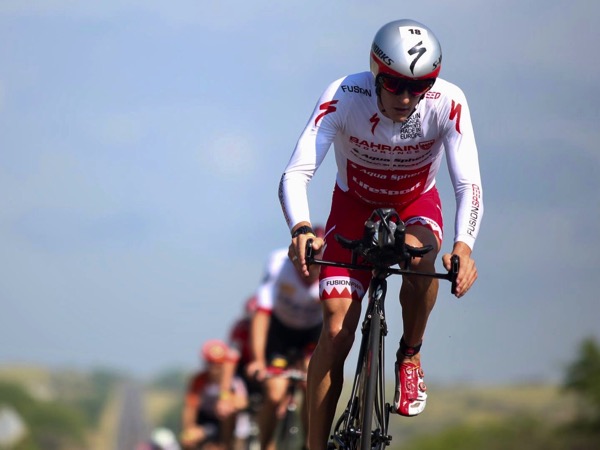
Photo: Brent leading a group of cyclists in the bike leg in Kona. (Credit: Jay Prasuhn)
Brent returns this year to defend his title and is the clear favorite for the South American Regional Championships. His preparation did not go completely according to plan: He hurt his hand in mid-March when racing SuperLeague and needed surgery. He had to take three weeks off from swim training, but was able to return to racing ahead of schedule with a 6th place at St. George in early May. He seems to be ready for a solid race in Florianopolis. He still needs some points for Kona, but a 9th place gives him quite a lot of “buffer” and it’s unlikely that he’ll “just play it safe”.
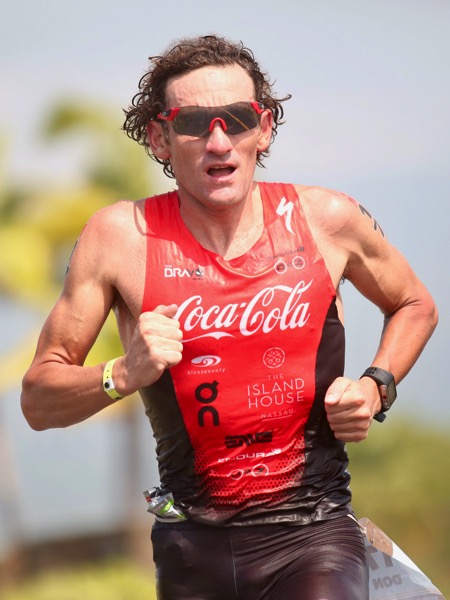
Last year’s second place finisher was Tim Don. Tim is mostly racing 70.3s and is always placing very well: His 2017 results include two wins at 70.3 Campeche and 70.3 Liuzhou and 4th place at 70.3 St. George. An eighth place finish should be sufficient for him to qualify for Kona, and even if placing really well in Brasil is probably not his main goal I’m sure he wouldn’t mind winning the race. In order to do that when Brent is racing well, Tim will need to step up his bike performance and try to stick with Brent on the bike and also on the run. I don’t think he’ll risk completely blowing, it’s more likely that he’ll be racing his own race and finish on the podium but probably not on the top spot.
Photo: Tim running towards a 15th place finish at Kona 2015. (Credit: Jay Prasuhn)
While I’m reasonably sure that Tim is going to have a solid race, there is more doubt about Andreas Raelert. Andy’s last longer race was in Kona after an injury-plagued 2016 season that saw him qualify in the last possible race – probably at a time when wasn’t completely healthy, resulting in a disappointing DNF.
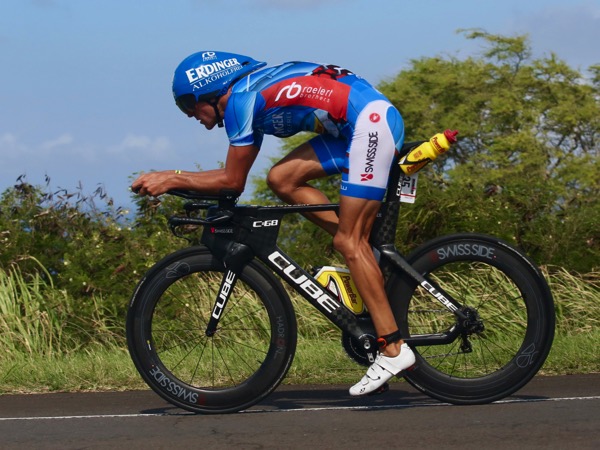
Photo: Andy on the bike at Kona 2015 where he was able to finish in second place. (Credit: Jay Prasuhn)
Andy has taken extra time during the winter to get healthy again, his fifth place at the shorter Cannes triathlon seems to indicate he’s back to running well. But Brasil is his first IM after the injury and he won’t know at what level he is until very late in the race. Even as a 40-year old he still targets a top finish in Kona, but he starts this season with zero Kona points. In order to have a shot at qualifying he needs a podium result, so he’ll have to be racing aggressively. I wouldn’t be surprised to see him try to bridge up to Brent and challenge him for the win – but his race could also end on the bike when his injury flares up again.
Another 40-year old athlete is Spaniard Eneko Llanos. He is always in a decent position in T2, but in his last long distance races he struggled to have a solid run and that’s required to place well in big Ironman races these days. A 3:11 run in South Africa saw him finish in 14th place, he’ll be looking for some Kona points in Florianopolis. Kyle Buckingham finished fourth at IM South Africa and is in a much better position for Kona Qualifying, just a Top 10 result should be enough for him to secure a July slot which is certainly an attainable goal for him. Matt Chrabot and Pedro Gomes will have to be on the podium for a reasonable chance to qualify – while unlikely it’s not impossible for them.
The Brazilian hopes will be riding on Igor Amorelli. Igor has won IM Brasil in 2014 and is an athlete with a good swim-bike combo. He won’t be too far back in T2, but he’ll have to run close to his marathon PR of 2:49 if he wants to finish on the podium. If he wants to qualify for Kona, he’ll need to finish fourth or better. Fabio Carvalho is a strong swimmer, if he can limit the time he looses on the bike his good run could see him finish in a similar position to last year when he was sixth and top Brazilian. But he’s also has had some explosions on the run, so it’s hard to predict where he’ll finish. Another Brazilian athlete to watch is Thiago Vinhal. A fifth place should be enough for him to qualify for Kona – and as far as I know he’d be the first African American athlete to do so.
There are a couple of great swimmers in the field: Luiz Franciso Paiva could be leading the field early on in his second Pro Ironman. The more established Barrett Brandon could also be the fastest swimmer, or Kona swim leader Harry Wiltshire. But “winning the swim” is probably the highlight of their race day – most of the overall contenders won’t be too far behind and will quickly take control of the race once on the bike..
Likely Race Development: Brent will enter T1 with the front group and will quickly take the lead on the bike, eventually entering T2 with a gap of at least three but even more likely five minutes to his chasers. He’ll likely extend the lead on the run, winning the race and posting another sub-8 finish. Last year there was a big chase group behind Brent, and that a likely scenario for this year as well. With Tim in that group, he’s the most likely candidate for second place even if Andy has a good swim and manages to be part of the chase group. I’m not sure if he thinks his run will be good enough to secure second place from within the group, so he could try to break up the chase group and make things interesting. But there are about eight podium candidates, so the race will be very close until the end, even if the main question is probably who will join Brent for the champagne ceremony.
Detailed Women’s Preview
A couple of years ago, the Female Pro race in Brazil was pretty difficult for the participants: The Pros started at the same time as the agegroupers which often resulted in the leading women racing in the middle of the fastest agegroupers. When bigger groups formed, it was tough not to be sucked into drafting – there is a limit to how often you sit up to let a group of drafting males pass. Things have improved since the Pros have their own start and the agegroupers start at least 15 minutes behind the Pro women. Extra diligence by the referees ensures that most of the females Pros can ride without any “cross-pollination” from faster agegroup racers. And while the male Pros often have similar strengths and therefore ride in closer proximity, there is a bit more variation among the female Pros. In short, the WPRO race has become a lot fairer than around 2010. Hopefully, this will be the case this year as well!
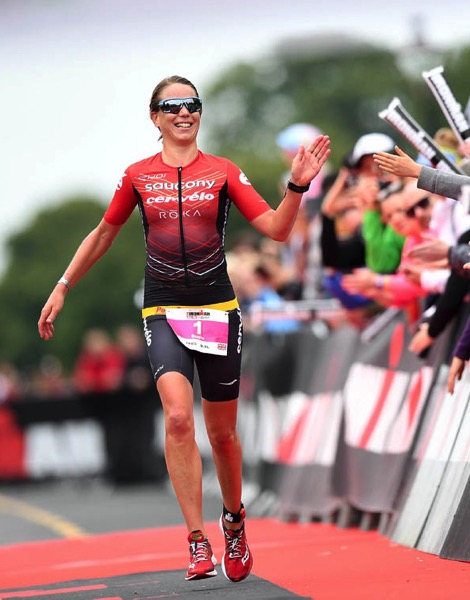
My top pick for IM Brasil is Susie Cheetham. Susie entered the Pro scene in 2015 with a third place at IM South Africa and a sixth place in Kona. 2016 was an up-and-down year for her: At the start of the season she crashed in 70.3 South Africa, breaking her elbow (but still finished). She need surgery to insert a wire and she had a lot of bike sessions on the trainer to get in shape for IM South Africa where she was probably racing “above her fitness” and took second place. Afterwards she needed some extra time for recovery and only raced a couple of 70.3s over the summer. She felt she was in great shape for Kona but early on the bike she sustained a muscle injury and couldn’t put out any power. A DNF was the unfortunate consequence.
Her first 2017 races show that she has left the injury behind her: A second place at 70.3 South Africa was followed by an Ironman PR at IM South Africa – still “only” good for a third place. This put her on a good track for Kona qualifying, but she still needs another good race. She decided to not wait too long to secure Kona qualifying – IM Brasil is just eight weeks later. “Not too short a gap so that you’re too tired from the last Ironman but also not too long so that you can’t hold onto and build on the fitness from the previous block of training and the race itself. I’ve put in some really good sessions and tested myself against targets that show I’m in good shape. I go into the race knowing I’ve prepared well and I’m in a good place.” Winning the race, running sub-3 or going sub-9 “would be incredible. I was close in South Africa so it’s certainly a possibility but it’s not my focus. First goal is to qualify, after that it’s to improve on my performance in South Africa.”
Photo: Susie winning 70.3 Dublin. (Credit: Getty for Ironman)
On paper Susie’s biggest challenge for the win can be expected from Linsey Corbin. Linsey, one of the most consistent Kona racers, struggled with a series of injuries in 2015.
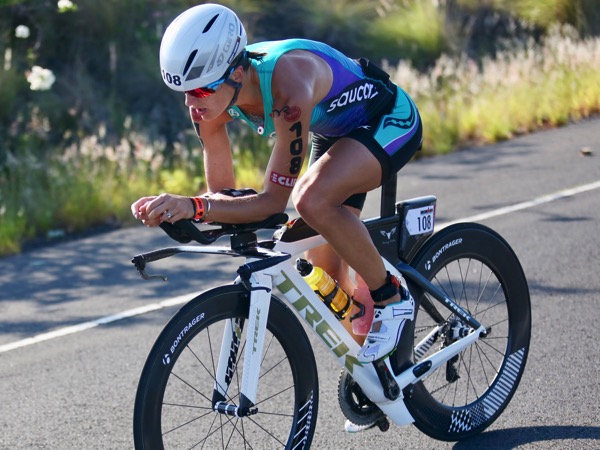
She has raced a number of 70.3s in 2016, and her two Ironman races (second at IM Cairns and 13th in Kona) were superb performances, even if “just short” of a win or Kona Top 10 that sponsors will be looking for. This year, she’d like to add a sixth Ironman title to her resume and has chosen to race IM Brasil “as my fitness is coming along nicely”. Her secondary goal is qualifying for Kona. While a win would take care of both of these goals, her “B goal” is likely a Top 5 finish which should give her enough points for a slot.
Photo: Linsey on the bike in Kona 2014. (Credit: Jay Prasuhn)
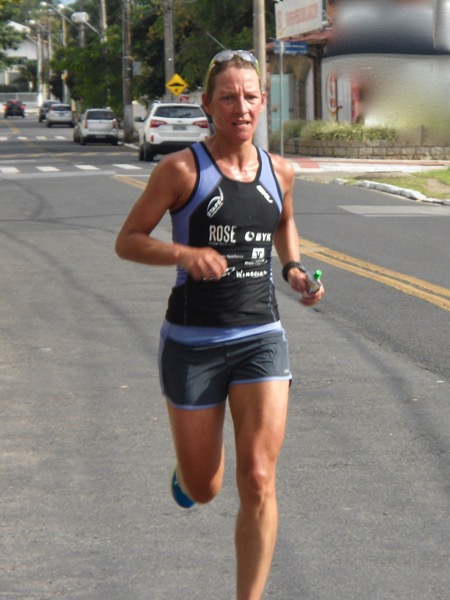
Third in my seedings is Mareen Hufe. She has had so many “almost” results that it’s hard to keep track: She was second in six Ironman races (including last year at IM Brasil) and also had a great 2015 Kona race .. except for that last few k on the run when she fell back from 8th place to an eventual 21st place finish. Mareen had to skip Kona 2016 when a niggle kept from doing decent run training, but she ended her 2016 season with two great second places (what else?) at IM Malaysia and IM Western Australia where she also went sub-9 for the first time. Mareen is one of the strongest female bike riders, but she has also improved on the run and seems to be “due” for a breakthrough performance.
Photo: Mareen on the run at IM Brasil 2015. (Credit: Private photo from Mareen)
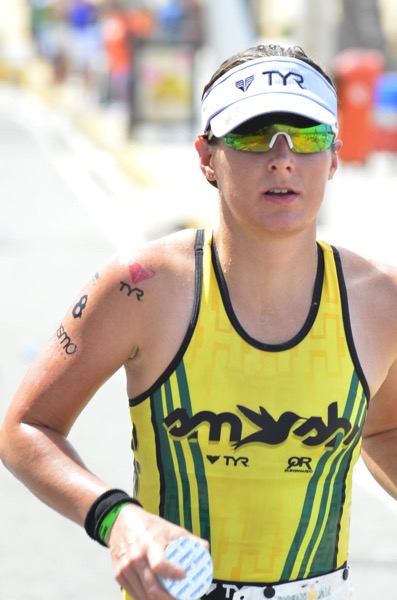 Haley Chura is another athlete that has had her share of injury woes. After winning the Brazilian Ironman in Fortaleza in 2014 (the only time it was a Pro race), she qualified early for Kona 2015. In one of her final bike sessions before flying to the Big Island she was hit by a car and suffered injuries that nearly kept her from starting in Kona. She was able to finish the swim but then DNF’d on the bike. After she was waiting for some time for the injuries to heal, things did not get any better – until it was finally discovered that she had a broken fibula. Since returning to racing in the summer of 2016, she has been consistently getting stronger on the 70.3 distance. A third place at the 2017 season opener in Pucon was the first run in a long time where she felt strong , and she followed that up with a win at 70.3 Buenos Aires by making up six minutes on the run. IM Brasil is her first IM in two years, but her recent results indicate that she’s in a better shape than she’s been in the past.
Haley Chura is another athlete that has had her share of injury woes. After winning the Brazilian Ironman in Fortaleza in 2014 (the only time it was a Pro race), she qualified early for Kona 2015. In one of her final bike sessions before flying to the Big Island she was hit by a car and suffered injuries that nearly kept her from starting in Kona. She was able to finish the swim but then DNF’d on the bike. After she was waiting for some time for the injuries to heal, things did not get any better – until it was finally discovered that she had a broken fibula. Since returning to racing in the summer of 2016, she has been consistently getting stronger on the 70.3 distance. A third place at the 2017 season opener in Pucon was the first run in a long time where she felt strong , and she followed that up with a win at 70.3 Buenos Aires by making up six minutes on the run. IM Brasil is her first IM in two years, but her recent results indicate that she’s in a better shape than she’s been in the past.
Photo: Haley on the run at IM Fortaleza. (Credit: MundoTri)
These four athletes – Susie, Linsey, Mareen and Haley, are solid, experienced athletes that can be predicted with reasonable confidence. Two more athletes could also be in the mix but are much harder to predict: Sonja Tajsich‘s last international race was two years ago when she qualified for Kona with a third place at IM Copenhagen. However she suffered a stress fracture late in the run and was forced to decline her slot. A few weeks later she announced that she was pregnant. Since giving birth to her second daughter Julia she has done a few smaller races in Germany, but IM Brasil is a big step up and it’s unclear what she’ll be able to do after going hard for seven or eight hours. Another “unknown on the full distance” is Canadian Magali Tisseire who is stepping up to the long distance in Florianopolis. Coming from the excellent results in 70.3 races the main question for her will be if she’s patient enough to save enough energy for the last hour on the run when the final order will be decided.
As is typical for a field in a Regional Championship there is also a large group of good athletes that can finish on the podium on the right day. Examples include Gurutze Frades, a strong runner who was third at last year’s IM Brasil and fifth in South Africa 2017. Lisi Gruber is a member of Siri Lindley’s training group, she was second in Barcelona at the end of last year. Annah Watkinson was third in Barcelona, she had a frustrating DNF in her “home IM” in South Africa and will be very motivated to have a better result in Brasil. Kristin Moeller is another strong runner, she often looses a lot of time on the swim and bike but is able to consistently run under three hours. Laurel Wassner has managed to qualify for Kona a couple of times in the past years.
The Brazilian hopes were riding on 2015 champion Ariane Monticelli, but she has had a serious training accident and is unable to race. All the best wishes to her for a full recovery! Mariana Andrade, Bruna Mahn and Carolina Furriela (doing her first IM after some success on the half distance) will probably be happy if they manage to finish “in the money” by claiming a spot in the Top 10.
Likely Race Development: There can’t be many doubts that Haley Chura, consistently one of the best Ironman swimmers, is going to lead the race in T1. It’ll be interesting to see how large the time gaps to the other main contenders are going to be – the expected gaps are five minutes to Susie, about eight minutes to Linsey and eleven minutes to Mareen. The capabilities on the bike are exactly reversed: Mareen should be the fastest on the bike, nominally overtaking Linsey and Susie and almost closing the gap to Haley. It’ll be interesting to see how Mareen paces the bike (in Western Australia she had a very strong second half of the bike) and if Linsey and Susie will try to go with her. We may very well have all four top contenders enter T2 in just a minute or two. Susie and Linsey have the exact same expected time for the run, it would be an awesome run duel if they start the run within sight of each other. Mareen would need a gap to these two great runners to have a shot at winning the race, but she’s worked hard to improve her run so I don’t think that Susie and Linsey should feel confident to catch her unless she is within five minutes of them. Nominally, Haley is the weakest runner of the four, but she has also made improvements on the run and if things go right for her she should set a new marathon PR (currently 3:15 from her win at Fortaleza). Adding in the “wild cards” of Sonja and Magali into the mix of these four, the female race promises to be a constant back and forth among the athletes – and very hard to predict who will end up on top and on the podium.
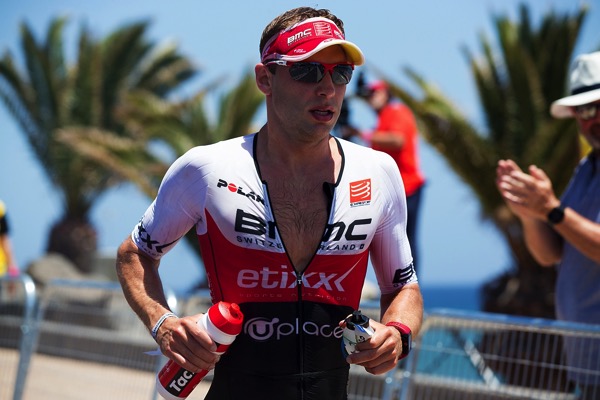
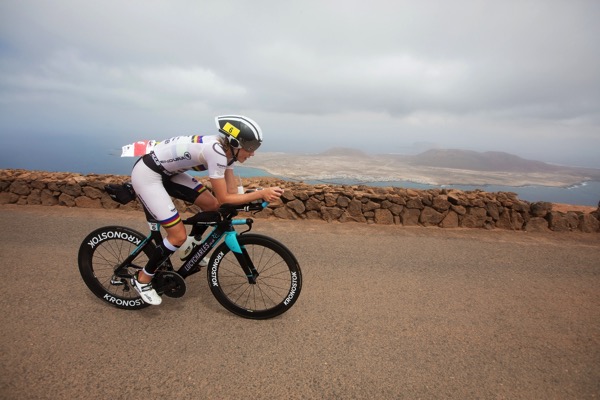
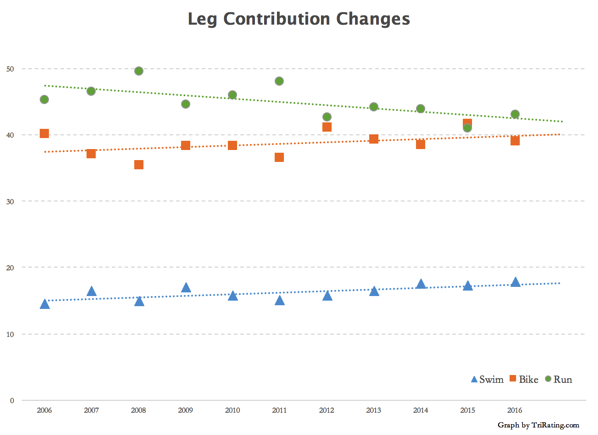
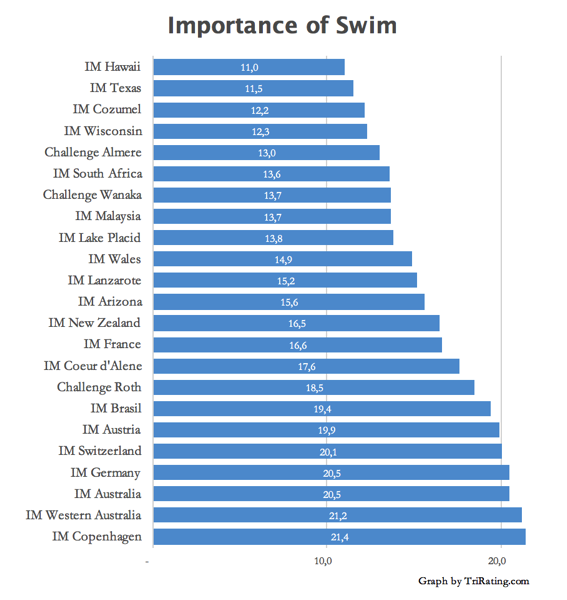
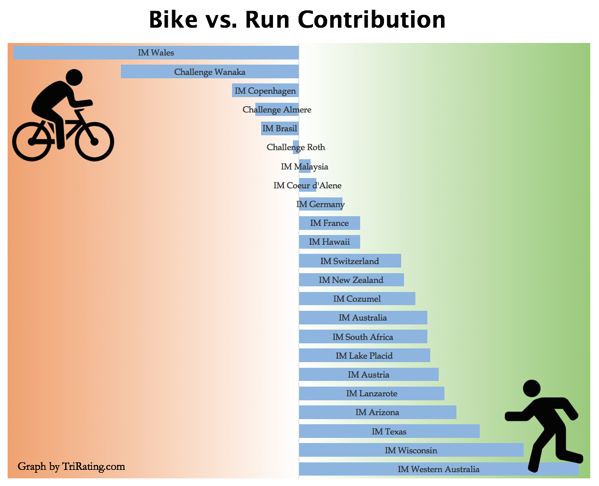
 The third of the Regional Championships is coming up – lots of Kona points, decent prize money and automatic qualifying spots for the two winners have attracted strong fields.
The third of the Regional Championships is coming up – lots of Kona points, decent prize money and automatic qualifying spots for the two winners have attracted strong fields.





 Haley Chura is another athlete that has had her share of injury woes. After winning the Brazilian Ironman in Fortaleza in 2014 (the only time it was a Pro race), she qualified early for Kona 2015. In one of her final bike sessions before flying to the Big Island she was hit by a car and suffered injuries that nearly kept her from starting in Kona. She was able to finish the swim but then DNF’d on the bike. After she was waiting for some time for the injuries to heal, things did not get any better – until it was finally discovered that she had a broken fibula. Since returning to racing in the summer of 2016, she has been consistently getting stronger on the 70.3 distance. A third place at the 2017 season opener in Pucon was the first run in a long time where she felt strong , and she followed that up with a win at 70.3 Buenos Aires by making up six minutes on the run. IM Brasil is her first IM in two years, but her recent results indicate that she’s in a better shape than she’s been in the past.
Haley Chura is another athlete that has had her share of injury woes. After winning the Brazilian Ironman in Fortaleza in 2014 (the only time it was a Pro race), she qualified early for Kona 2015. In one of her final bike sessions before flying to the Big Island she was hit by a car and suffered injuries that nearly kept her from starting in Kona. She was able to finish the swim but then DNF’d on the bike. After she was waiting for some time for the injuries to heal, things did not get any better – until it was finally discovered that she had a broken fibula. Since returning to racing in the summer of 2016, she has been consistently getting stronger on the 70.3 distance. A third place at the 2017 season opener in Pucon was the first run in a long time where she felt strong , and she followed that up with a win at 70.3 Buenos Aires by making up six minutes on the run. IM Brasil is her first IM in two years, but her recent results indicate that she’s in a better shape than she’s been in the past.